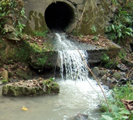


Berkeley Lab Interim Director Paul Alivisatos presents a State-of-the-Lab address today at 9 a.m. in the Building 66 Auditorium (limited seating available). Staff can watch the address via webcast on their computers, or attend group broadcasts in Perseverance Hall (54-0130), 50B-4205, 90-3122, 84-0318, and JGI-149C. Those watching remotely can e-mail inquiries to [email protected] (put "SOTL" in subject line).
 Research: Closer to the First Millionth of a Second
Research: Closer to the First Millionth of a Second The ALICE detector at CERN’s Large Hadron Collider will study the fireballs that result when energetic lead ions collide, recreating conditions like those when the universe was just a millionth of a second old. An ALICE instrument called EMCal will signal the most interesting events. Designed by an international collaboration spearheaded by scientists and engineers at Berkeley Lab and other U.S. institutions, EMCal is now on its way to completion. More>
 [San Francisco Chronicle] More than a year ago, four East Bay mayors joined the heads of UC Berkeley and Berkeley Lab to announce their intention to make the East Bay "the Silicon Valley of the green economy." In June, the corridor's membership will double to 12 partners with the addition of four more cities and two community college districts. Yet obstacles remain for the partnership, which has been somewhat shaken by the economic earthquake that has made venture capital less venturesome in many fields, including clean tech. More>
[San Francisco Chronicle] More than a year ago, four East Bay mayors joined the heads of UC Berkeley and Berkeley Lab to announce their intention to make the East Bay "the Silicon Valley of the green economy." In June, the corridor's membership will double to 12 partners with the addition of four more cities and two community college districts. Yet obstacles remain for the partnership, which has been somewhat shaken by the economic earthquake that has made venture capital less venturesome in many fields, including clean tech. More>
 [BBC News] A revolution in genome screening has been promised by a biotech company in the US. Complete Genomics says it will sequence one thousand complete genomes between June 2009 and the end of the year and one million over five years. "We don't understand much about the genome yet despite all the years we've been studying it, although new technologies are enabling us to learn about it faster and faster,” says Steven Brenner, with Berkeley Lab’s Physical Biosciences Division. More>
[BBC News] A revolution in genome screening has been promised by a biotech company in the US. Complete Genomics says it will sequence one thousand complete genomes between June 2009 and the end of the year and one million over five years. "We don't understand much about the genome yet despite all the years we've been studying it, although new technologies are enabling us to learn about it faster and faster,” says Steven Brenner, with Berkeley Lab’s Physical Biosciences Division. More>
 In The News: Sewage Spills Increasing
In The News: Sewage Spills Increasing[KQED] How much sewage makes its way into our water? Plenty. Statewide, it's likely that last year's record number, 20 million gallons of raw sewage dumped in California waterways, is going to be broken this year. Decrepit pipes, lack of money and the growing severity of storms could all add up to a disaster of septic proportions. Berkeley Lab earth scientist Norm Miller is quoted in the story. More>
 Year of Science: Lab Feature Honors April’s Energy Theme
Year of Science: Lab Feature Honors April’s Energy ThemeAs stars go, from the standpoint of the universe, our Sun is nothing extraordinary: a yellow dwarf made up mostly of hydrogen just like at least 100 million other class G2 stars in the Milky Way. But for Earth, the Sun is a one-of-a-kind superstar — a bountiful source of energy that separates our bright living world from a dark dead rock. This same life-sustaining bounty of energy also represents humankind’s ultimate hope for developing energy technologies that are environmentally clean, carbon neutral — meaning they do not exacerbate global warming — and renewable for as long as it matters. More>
 World of Science: New Quantum Diaries Looking for Lab Bloggers
World of Science: New Quantum Diaries Looking for Lab BloggersThe international InterAction Collaboration of physics communicators has relaunched the Quantum Diaries website, a personal look at the daily lives of particle physicists from around the world through their bios, videos, photos, and blogs. Quantum Diaries originally appeared during 2005 for the World Year of Physics. The updated site has a new crew and plans to add bloggers every few months to maintain an ongoing record of life on the cosmic frontier of high-energy physics. Interested bloggers at Berkeley Lab, contact Paul Preuss for more information. More>
Today at Berkeley Lab is produced by Public Affairs' Communications Department